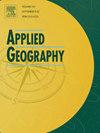Advancing facility accessibility analysis across hierarchies and scales in mainland China
IF 4
2区 地球科学
Q1 GEOGRAPHY
引用次数: 0
Abstract
With rapid urbanization and the expansion of national transportation system, versatile service facilities have emerged, ranging from urban services meeting daily needs to national facilities catering to specialized demands. Ensuring efficient and equitable access to multi-level facilities is critical for promoting a nation's sustainable development. Despite extensive research on urban facility accessibility, an integrative assessment of multi-level facility access—particularly inter-regional access to national facilities—remains underexplored. To fill this gap, this study proposes a nationwide hierarchical classification system, categorizing facilities into three levels—urban, provincial, and national—based on service range and spatial distribution. Tailored accessibility calculation methods are developed for each level, incorporating road, rail, and air transport. Results from mainland China reveal stark disparities across facility levels: Urban healthcare services exhibit the highest accessibility but significant spatial inequality, whereas national-level theme parks show the lowest accessibility yet the highest spatial equality. Additionally, accessibility determinants display a hierarchical pattern: facility density dominates urban facility accessibility, while administrative area size and GDP govern access to provincial and national facilities, respectively. Furthermore, HSR and air transport enhance access to national facilities while reducing inequality. These findings provide actionable insights for optimizing facility distribution and accessibility across hierarchical spatial scales.
推进中国大陆跨层次和尺度的设施可达性分析
随着城市化的快速发展和国家交通系统的扩大,出现了多种多样的服务设施,从满足日常需求的城市服务设施到满足特殊需求的国家设施。确保高效、公平地使用多层次设施对于促进国家的可持续发展至关重要。尽管对城市设施可达性进行了广泛的研究,但对多层次设施可达性的综合评估,尤其是对国家设施的区域间可达性的评估,仍未得到充分探索。为了填补这一空白,本研究提出了一个全国范围内的分级分类系统,根据服务范围和空间分布将设施分为三个级别--城市、省级和国家级。针对每个级别,结合公路、铁路和航空运输,制定了量身定制的可达性计算方法。中国大陆的研究结果显示,不同级别的设施之间存在明显差异:城市医疗服务的可达性最高,但空间不平等现象严重;而国家级主题公园的可达性最低,但空间平等程度最高。此外,可及性的决定因素呈现出等级模式:设施密度主导着城市设施的可及性,而行政区域面积和 GDP 则分别制约着省级和国家级设施的可及性。此外,高铁和航空运输在减少不平等的同时,也提高了国家设施的可及性。这些发现为优化分级空间尺度的设施分布和可达性提供了可操作的见解。
本文章由计算机程序翻译,如有差异,请以英文原文为准。
求助全文
约1分钟内获得全文
求助全文
来源期刊

Applied Geography
GEOGRAPHY-
CiteScore
8.00
自引率
2.00%
发文量
134
期刊介绍:
Applied Geography is a journal devoted to the publication of research which utilizes geographic approaches (human, physical, nature-society and GIScience) to resolve human problems that have a spatial dimension. These problems may be related to the assessment, management and allocation of the world physical and/or human resources. The underlying rationale of the journal is that only through a clear understanding of the relevant societal, physical, and coupled natural-humans systems can we resolve such problems. Papers are invited on any theme involving the application of geographical theory and methodology in the resolution of human problems.
 求助内容:
求助内容: 应助结果提醒方式:
应助结果提醒方式:


